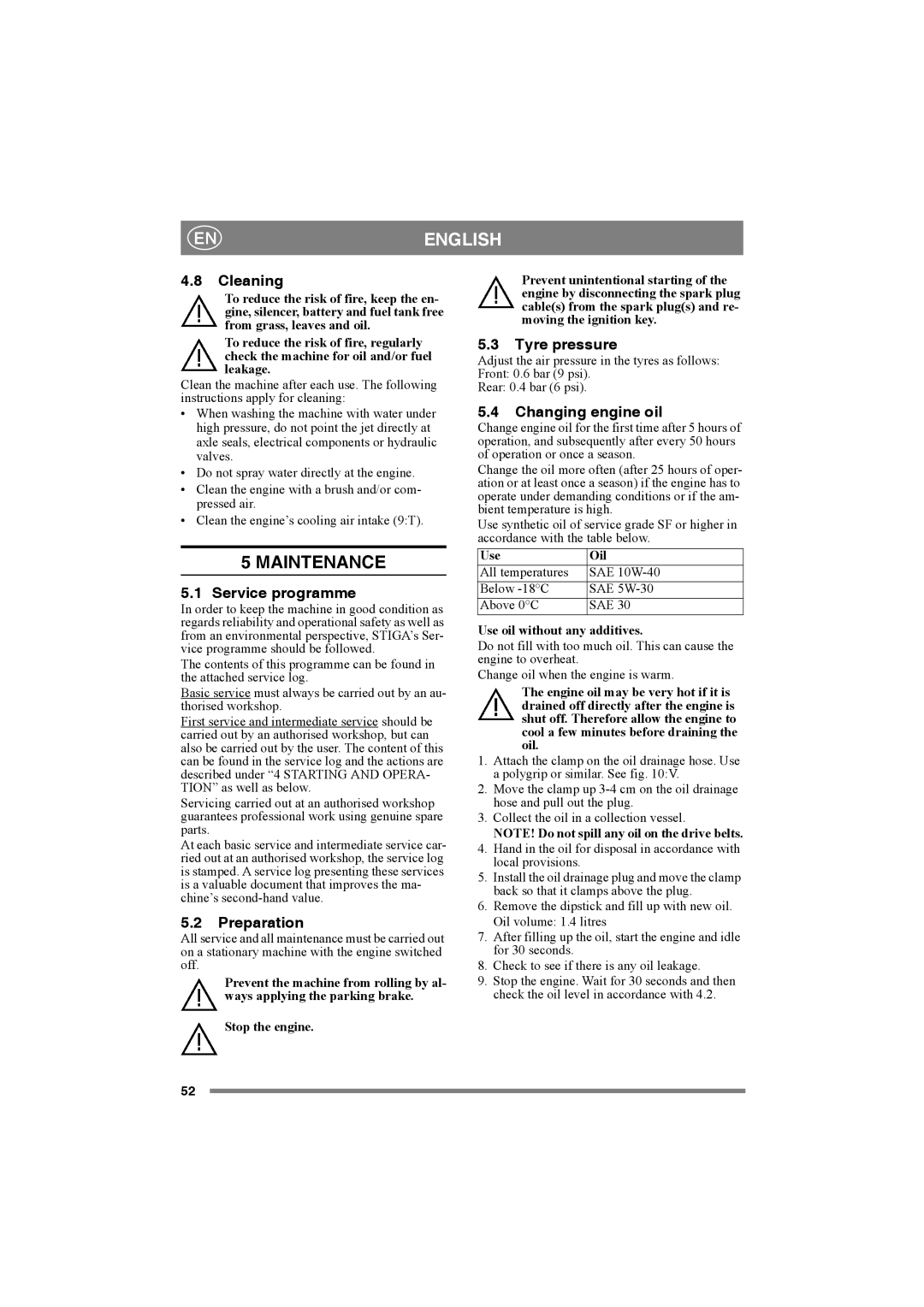
ENENGLISH
4.8Cleaning
To reduce the risk of fire, keep the en- gine, silencer, battery and fuel tank free from grass, leaves and oil.
To reduce the risk of fire, regularly check the machine for oil and/or fuel leakage.
Clean the machine after each use. The following instructions apply for cleaning:
•When washing the machine with water under high pressure, do not point the jet directly at axle seals, electrical components or hydraulic valves.
•Do not spray water directly at the engine.
•Clean the engine with a brush and/or com- pressed air.
•Clean the engine’s cooling air intake (9:T).
5MAINTENANCE
5.1Service programme
In order to keep the machine in good condition as regards reliability and operational safety as well as from an environmental perspective, STIGA’s Ser- vice programme should be followed.
The contents of this programme can be found in the attached service log.
Basic service must always be carried out by an au- thorised workshop.
First service and intermediate service should be carried out by an authorised workshop, but can also be carried out by the user. The content of this can be found in the service log and the actions are described under “4 STARTING AND OPERA- TION” as well as below.
Servicing carried out at an authorised workshop guarantees professional work using genuine spare parts.
At each basic service and intermediate service car- ried out at an authorised workshop, the service log is stamped. A service log presenting these services is a valuable document that improves the ma- chine’s
5.2Preparation
All service and all maintenance must be carried out on a stationary machine with the engine switched off.
Prevent the machine from rolling by al- ways applying the parking brake.
Stop the engine.
Prevent unintentional starting of the engine by disconnecting the spark plug cable(s) from the spark plug(s) and re- moving the ignition key.
5.3Tyre pressure
Adjust the air pressure in the tyres as follows: Front: 0.6 bar (9 psi).
Rear: 0.4 bar (6 psi).
5.4Changing engine oil
Change engine oil for the first time after 5 hours of operation, and subsequently after every 50 hours of operation or once a season.
Change the oil more often (after 25 hours of oper- ation or at least once a season) if the engine has to operate under demanding conditions or if the am- bient temperature is high.
Use synthetic oil of service grade SF or higher in accordance with the table below.
Use | Oil |
All temperatures | SAE |
Below | SAE |
Above 0°C | SAE 30 |
Use oil without any additives.
Do not fill with too much oil. This can cause the engine to overheat.
Change oil when the engine is warm.
The engine oil may be very hot if it is drained off directly after the engine is shut off. Therefore allow the engine to cool a few minutes before draining the oil.
1.Attach the clamp on the oil drainage hose. Use a polygrip or similar. See fig. 10:V.
2.Move the clamp up
3.Collect the oil in a collection vessel.
NOTE! Do not spill any oil on the drive belts.
4.Hand in the oil for disposal in accordance with local provisions.
5.Install the oil drainage plug and move the clamp back so that it clamps above the plug.
6.Remove the dipstick and fill up with new oil. Oil volume: 1.4 litres
7.After filling up the oil, start the engine and idle for 30 seconds.
8.Check to see if there is any oil leakage.
9.Stop the engine. Wait for 30 seconds and then check the oil level in accordance with 4.2.
52
